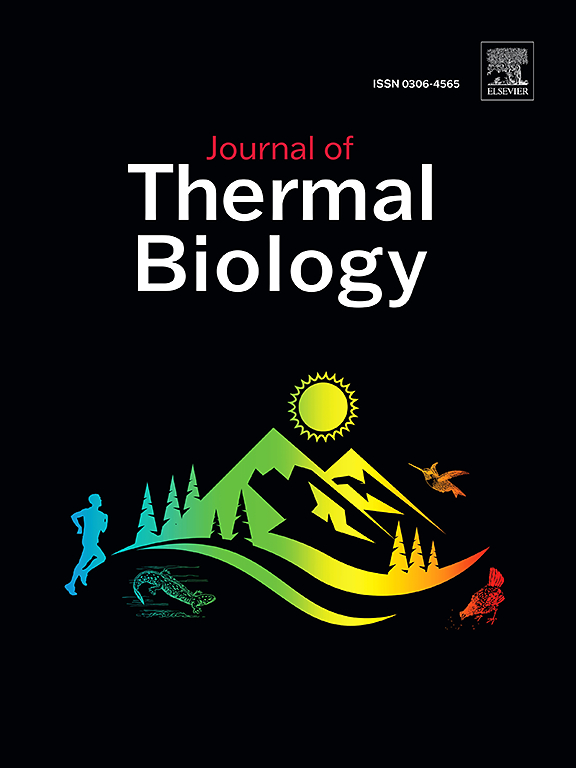生活阶段和季节在腐尸甲虫临界热极限中的作用
IF 2.9
2区 生物学
Q2 BIOLOGY
引用次数: 0
摘要
幼虫和冬季热极限对于理解对气候变化的响应可能至关重要,但许多关于昆虫临界热极限的研究都集中在良性条件下(实验室或夏季野外条件)饲养的成虫。一般来说,昆虫的温度变异性与热耐受宽度是相关的。因此,我们预测,与在有限的小气候中发育的流动性较差的幼虫相比,成虫的热限制更广。我们还预测冬季成虫的低温极限比夏季成虫低。为了测试不同生命阶段和季节的这种热变化,我们使用循环浴来确定两种科罗拉多腐尸甲虫(鞘翅目:Staphylinidae: Silphinae)的临界热极限,其中幼虫在胴体小气候中发育。为了进行幼虫和成虫的比较,我们使用了夏季lapponicus Thanatophilus(111)和coloradensis Thanatophilus(46)。冬季和夏季的比较,我们使用了成虫(n = 103)。在野外捕获的成虫、繁殖的幼虫和繁殖的成虫的热上限(CTmax)和热下限(CTmin)上,我们检测到幼虫和成虫的热上限(CTmax)没有差异。野生成虫CTmin(- 5.7±0.5°C)明显低于野生幼虫(- 3.0±1.3°C)和繁殖幼虫(- 3.5±0.8°C),但CTmax无显著差异。冬季成虫CTmin(- 2.8±1.6°C)比夏季成虫CTmax(- 1.9±1.9°C)低近1℃,但CTmax差异无统计学意义。这些结果表明,即使是密切相关的共同发生的物种也可以有不同的策略来应对寒冷的温度。而且,在某些情况下,特别是对高海拔的专家来说,幼虫可能会从温度缓冲的小气候中受益。耐热性广泛,在生命阶段和季节变化较小,强调寒冷温度的变化对气候变化的响应至关重要,例如,积雪水平的变化会影响绝缘。本文章由计算机程序翻译,如有差异,请以英文原文为准。
The role of life stage and season in critical thermal limits of carrion beetles
Larval and winter thermal limits may be vital for understanding responses to climate variability, but many studies of insect critical thermal limits focus on adults reared in benign conditions (lab or summer field conditions). For insects generally, temperature variability and thermal tolerance breadth are correlated. Thus, we predict broader thermal limits in adults compared to less-mobile larvae developing within a restricted microclimate. We also predict lower cold limits in winter adults compared to summer adults. To test for this thermal variability across life stages and seasons, we used a recirculating bath to determine critical thermal limits in two species of Colorado carrion beetles (Coleoptera: Staphylinidae: Silphinae) in which larvae develop within a carcass microclimate. For larval and adult comparisons, we used summer Thanatophilus lapponicus (n = 111) and Thanatophilus coloradensis (n = 46). For winter and summer comparisons, we used adult T. lapponicus (n = 103). We detected no difference between larvae and adults in T. lapponicus for either upper thermal limits (CTmax) or lower thermal limits (CTmin) for wild caught adults, bred larvae, and bred adults. In contrast, wild caught adults of T. coloradensis had a significantly lower CTmin (−5.7 ± 0.5 °C) compared to wild caught larvae (−3.0 ± 1.3 °C) and bred larvae (−3.5 ± 0.8 °C) with no difference in CTmax. Winter T. lapponicus adults displayed a nearly one-degree lower CTmin (−2.8 ± 1.6 °C) than summer adults (−1.9 ± 1.9 °C) with no difference in CTmax. These results demonstrate that even closely related, co-occurring species can have distinct strategies for coping with cold temperatures. And, in some cases, particularly for high-elevation specialists, larvae may benefit from a temperature-buffered microclimate. Heat tolerance was broad and less variable across life stages and seasons, emphasizing that variation in cold temperatures will be critical for responses to climate change, for example, changes in snow levels impacting insulation.
求助全文
通过发布文献求助,成功后即可免费获取论文全文。
去求助
来源期刊

Journal of thermal biology
生物-动物学
CiteScore
5.30
自引率
7.40%
发文量
196
审稿时长
14.5 weeks
期刊介绍:
The Journal of Thermal Biology publishes articles that advance our knowledge on the ways and mechanisms through which temperature affects man and animals. This includes studies of their responses to these effects and on the ecological consequences. Directly relevant to this theme are:
• The mechanisms of thermal limitation, heat and cold injury, and the resistance of organisms to extremes of temperature
• The mechanisms involved in acclimation, acclimatization and evolutionary adaptation to temperature
• Mechanisms underlying the patterns of hibernation, torpor, dormancy, aestivation and diapause
• Effects of temperature on reproduction and development, growth, ageing and life-span
• Studies on modelling heat transfer between organisms and their environment
• The contributions of temperature to effects of climate change on animal species and man
• Studies of conservation biology and physiology related to temperature
• Behavioural and physiological regulation of body temperature including its pathophysiology and fever
• Medical applications of hypo- and hyperthermia
Article types:
• Original articles
• Review articles
 求助内容:
求助内容: 应助结果提醒方式:
应助结果提醒方式:


